Temporary Open Restaurants Program FAQ
Updated August 2023
Temporary Open Restaurants Program Update
At this time we are no longer accepting new applications under the temporary program. The permanent program is in development, with timeline and application details to be shared as they become available.Who is eligible to apply to Open Restaurants?
When can my establishment begin using outdoor dining?
I already have outdoor dining space, do I need to apply?
- Restaurants utilizing any privately owned outdoor space, such as front yards, side yards, rear yards or courtyards
- Restaurants utilizing private parking lots
- Restaurants utilizing balconies, terraces, or open air rooftop space
- Restaurants on open air boats
My establishment is in a residential district, special district, or historic district where sidewalk cafes are not typically allowed, can I still apply?
Can I apply if I’m on an Open Street?
Is there a fee to apply to Open Restaurants?
Do I need insurance?
What is the duration of Open Restaurants?
Can my barriers and furniture remain in the roadway when I’m not in operation?
Is the seating exclusive to my business and can I serve food?
Can I serve alcoholic beverages in the outdoor dining area?
Can I use the seating area for performances or other types of activity?
Are street vendors allowed to use the curb lane or sidewalk?
Is Open Restaurant Seating ADA accessible?
How does the Alternate Side Parking (“ASP") regulation impact seating in the roadway?
Can I use elements besides furniture, barriers, and ramps?
Can I use the plaza in front of my business?
Can I apply for roadway seating if there is a bus stop or bike lane in front of my business?
What if something is already installed on the sidewalk or roadway in front of my establishment, such as a bike corral or Citi Bike station?
What if there is an underground utility or transportation grate in the area?
Can I place seating on the sidewalk adjacent to the curb in the ‘amenity zone’?
Can I set up tables on both sides of my very wide sidewalk as long as there is an 8-foot pedestrian pathway between?
How do I know if the roadway in front of my business is eligible for Open Restaurants?
Can I add lighting to seating areas?
Are heating elements allowed?
- Electric radiant heaters will be allowed in both sidewalk and roadway seating setups. Full electric radiant heater guidance from the Department of Buildings (pdf)
- Natural gas radiant heaters will be allowed on the sidewalk only. Full natural gas radiant heater guidance from the Department of Buildings (pdf). Natural gas radiant heaters must also comply with the Fire Code
May I prepare, cook or warm food in my outdoor dining areas?
Is smoking allowed in outdoor dining areas?
My ground floor restaurant is on a corner and has two frontages. How do I indicate Total Length (ft) and Total Width (ft) of outdoor dining dimensions on the Open Restaurants application?
I plan on serving alcohol at my establishment and am filling out the SLA requirements on the Open Restaurants application. What is the Name of Certificant, and is it different from the Licensee?
When will my restaurant be inspected and by whom?
What happens if I receive a Notice to Correct or Termination Order?
I was issued a Notice to Correct or Termination Order due to non-compliance. I’ve fixed the issue, or am actively working to fix the issue; how can I contact someone at NYC DOT to let them know?
Will I be fined $1,000 without a warning?
I have an outdoor dining setup, but no longer wish to use it and cannot afford the cost to remove the structure. What should I do?
Under what circumstances will I need to move or remove an outdoor dining setup in the street?
- All roadway and sidewalk seating elements must be removed when a city agency, utility company or other contractor needs to access the space for installation or repair. This includes tents, barriers, tables, chairs, portable heaters, etc.
- Some roadway seating elements need to be removed during a snow alert when roadway dining is suspended. Those that are not easily removed must be consolidated to the greatest extent possible.
- Roadway and sidewalk seating elements may need to be removed for routine or emergency tree work. Little advance notice may be provided for emergency work.
What if there is a tree in the sidewalk adjacent to my restaurant?
- Tree removal
- Tree pruning
- Attaching lights or other materials to trees
- Constructing any structure within or over a tree bed
Any food service establishment licensed by the NYC Department of Health and Mental Hygiene (DOHMH) which has business frontage on the ground floor.
Establishments may begin using outdoor dining right after completing the self-certification application online at nyc.gov/openrestaurants. You will receive a confirmation email once the application has been completed.
Types of outdoor dining which do not require NYC DOT approvals (but may require State Liquor Authority approvals) include:
Yes, you can apply. Visit the Open Restaurants webpage for more information.
Yes, establishments that are currently on an Open Streets may apply for sidewalk and/or roadway seating. To view all Open Street locations visit nyc.gov/openstreets
The City does not charge any fees to apply to the program at this time.
Yes, the City recommends you consult your insurance broker to make sure you have the appropriate coverage for the additional seating areas.
The permanent Open Restaurants program is in development. The City is committed to retaining the temporary program until the permanent program is in place.
Yes, however, tables and chairs must be removed or secured in place when not in use. For part-time moving lanes, all barriers and furniture must be removed during the period the curb lane functions as a moving lane.
Yes, seating is exclusive to your business and table service is allowed.
Yes, if you submit all appropriate documents to the State Liquor Authority (SLA) and are licensed by SLA. Please refer to the SLA's guidance for information on how to incorporate your outdoor dining area into the premises covered by your liquor license.
No. The program is for outdoor dining only. No other uses, including but not limited to, art galleries, live music and performing arts activities, are permitted. Amplified sound is not permitted as part of the Open Restaurants program.
Yes, as long as they comply with all applicable vending laws, rules, and regulations, and all NYC Department of Health and Mental Hygiene guidance.
Yes, the City requires all Open Restaurant seating to be ADA compliant. For setup requirements, visit the Open Restaurants webpage. Also visit MOPD’s Small Business Resources page for guidance.
ASP spaces are available for Open Restaurant use, provided all other requirements are met. By participating in the program, you are taking responsibility for maintaining the cleanliness of the roadway curb space in front of your business. Curbside drainage and access to and ventilation of utility covers must not be impeded, and at all times, the seating area must be in a clean, neat and safe condition.
Yes, umbrellas with a weighted base or tents or other shelters, not to exceed 400 square feet in total, are permitted. Installation must be per manufacturer instructions to secure the tents properly and safely. Umbrellas and tents may not extend past the barrier or obstruct access to or ventilation of utility covers. Areas of multiple tents that are combined or are tied to each other cannot exceed 400 square feet in total. Umbrellas and tents should not be used during inclement weather such as high wind condition.
Outdoor dining setups or additions of any kind may not be bolted down or drilled into the roadway, sidewalk or adjacent buildings.
Outdoor dining setups, tents or umbrellas may not block any right of way signs or street regulation signs.
Platforms may not be installed on sidewalks but may be installed in authorized roadway seating areas behind the required barrier to height flush with the curb to facilitate ADA compliance, prevent the curb from becoming a tripping hazard, and allow drainage to underpass seating. Such platforms shall not block rainwater drainage getting to the curb or flowing along the curb and shall not obstruct access to or ventilation of utility covers.
Restaurants can work with their local BID and NYC DOT to request additional seating in plazas by emailing Plazas@dot.nyc.gov.
Roadway seating may not be placed in a bus stop, bike lane, taxi stand, Carshare parking space, painted curb extension or expanded sidewalk, designated buffer zone (area with white markings separating a bike or parking lane from a travel lane), or vehicular moving lane.
Roadway seating may be set up in a bus lane as long as all barriers, seating and ramps are removed during the hours No Standing is in effect (more in the “roadway eligibility” FAQ).
Roadway seating may be set up in a floating parking lane adjacent to a bike lane, in front of an approved business per the diagram below.
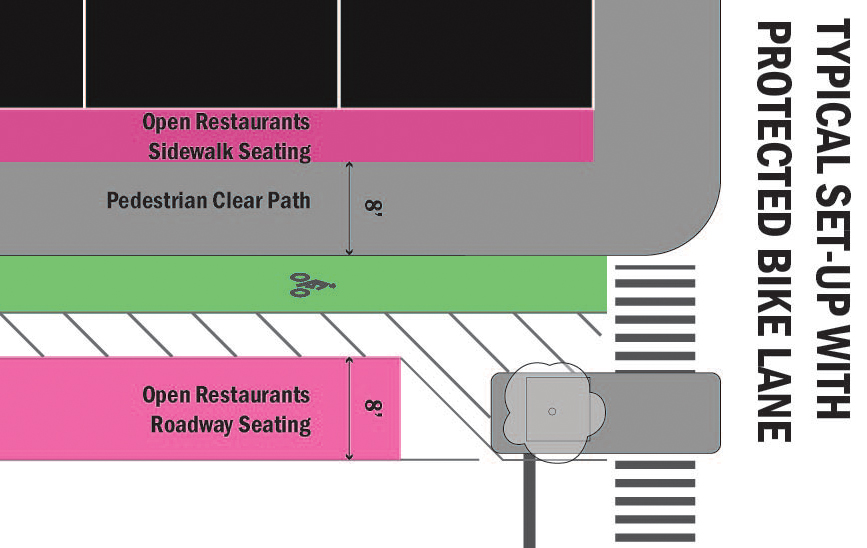
The City will not remove nor relocate street furniture or trees for the purposes of accommodating outdoor dining. If a Citi Bike station is installed in the curb lane, roadway seating may not be set up. Additionally, the establishment cannot remove any City property already installed on the sidewalk or curb lane in front of their establishment. Such removal by the establishment may result in a fine.
Outdoor dining setups must NOT block, cover or otherwise negatively impact access to utility covers or transportation grates. This includes, but is not limited to, manholes and electric provider boxes, as well as subway ventilation grates. ConEdison’s Outdoor Dining Safety Requirements ConEdison’s Manhole Safety Information
No, sidewalk seating is only permitted directly adjacent to the building façade provided an 8’ clear path to the curb is maintained. The area on the sidewalk adjacent to the curb is known as the “amenity zone” and structures of any kind are not permitted. Learn more about the anatomy of a sidewall in the NYC DOT Pedestrian Mobility Plan
No, you may only utilize the sidewalk space alongside your storefront and/or the parking lane in the roadbed for seating. Eight feet (8’) is the MINIMUM requirement for a pedestrian pathway. See Siting Criteria image for reference.
Below is a list of the different street signs and whether they indicate if your roadway is eligible for Open Restaurants. Descriptions of Parking Regulation Signs
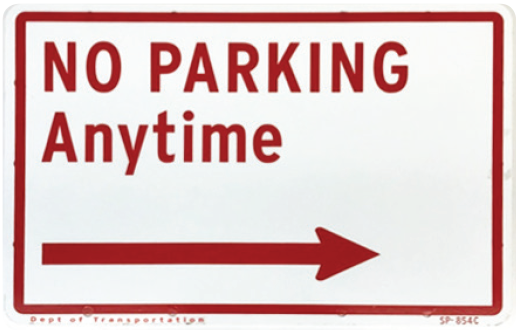
Yes. You may use the roadway for dining if this is the sign in front of your business.

Yes. You may use alternate side of the street parking spaces in front of your business for outdoor dining.

No. You may not use the roadway in front of your business if there’s a No Standing Anytime sign.
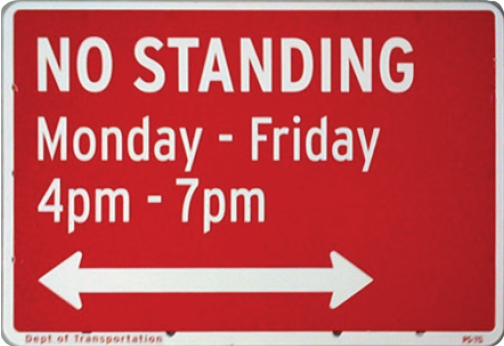
Yes with restrictions. You may use the roadway space during the hours No Standing is NOT in effect. You must remove all barriers, seating and ramps during the hours No Standing is in effect. This applies to signs that dedicate the space to a specific use during the restricted times. For example, this could include, but is not limited to, a sign that reserves the space for “Farmers Market Only Friday and Saturday from 8am-10am”. In this example, the space must remain clear from 8am-10am on Friday and Saturday to accommodate the Farmers Market use.
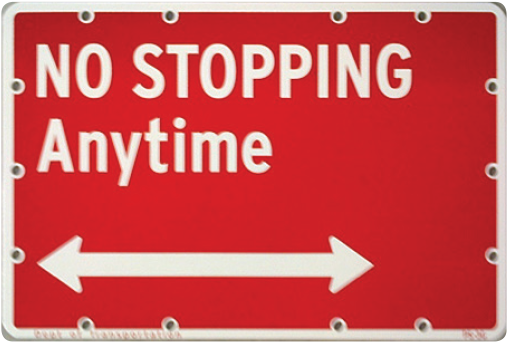
No. You may not use the roadway in front of your business if there’s a No Stopping Anytime sign.
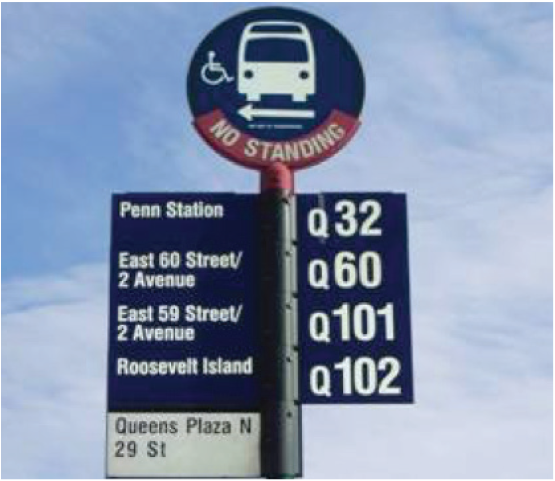
No. You may not use the roadway in front of your business if it’s in a bus stop.
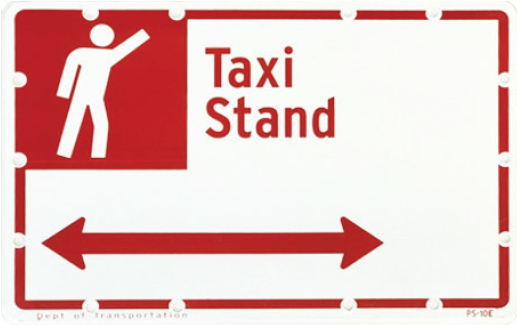
No.
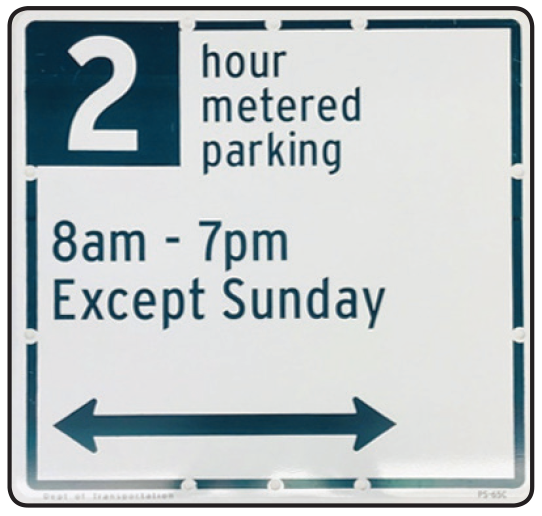
Yes. You may use the roadway in front of your business.
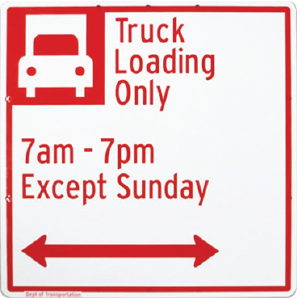

Yes. You may use the roadway in front of your business.
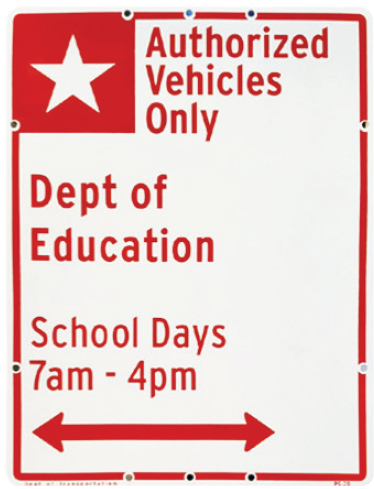
Yes with Restrictions. You may use the roadway during the hours not included on the sign. Some parking spaces are reserved all the time for Authorized Vehicles and those spaces may never be used by your business. All barriers, seating and ramps must be removed during the hours listed on the sign.
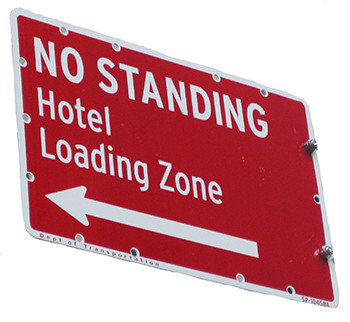
Yes with Restrictions. You may use the roadway if you are the hotel or an establishment associated with the hotel and have the hotel’s permission.
Yes, provided lighting is not blinding to passing traffic and complies with NYC Fire Department Open Flame and other applicable Fire Codes, and NYC Department of Building’s (DOB) Electrical Codes relating to outdoor wiring. Lights may not be attached to trees without a permit from The Department of Parks and Recreation (NYC Parks). Additionally, NYC street light wiring may not be used to connect any external power or lighting source.
Yes, the City will allow restaurants to incorporate heating elements in outdoor dining setups during New York City’s “heat season,” which generally starts in October until the following May. Heating elements shall be placed at least five feet (5’) from the trunk or branches of City trees.
Participants in the Open Restaurants program interested in providing comfort heating for their customers in outdoor dining areas have two options:
Propane heaters are not allowed.
No. No cooking, barbequing, nor open flames (i.e. ethanol gel chafing fuel) are allowed in roadway nor sidewalk seating areas.
No. Smoking and electronic cigarette use is not allowed in outdoor dining areas. Vaping and hookah smoking is not allowed.
Add the length of both sides to answer Total Length (ft). Your width should be the same on either side, so to answer Total Width (ft), use that value.
Yes, they are different. The certificant is the owner of the business who is on the liquor license and the licensee is the business name.
NYC DOT inspectors will make both proactive and complaint-driven visits. NYC Parks may also conduct both proactive and complaint-driven tree inspections, which typically do not require interaction with the business owner.
If your outdoor dining setup is found to be in violation of the Open Restaurants regulations, you may be issued a Notice to Correct. A Notice to Correct gives you a certain number of days to remedy violations. Should violations not be remedied, you may be subject to a Termination Order and a $1,000 penalty.
A Termination Order terminates your authorization to participate in the Open Restaurants program and requires you to remove your outdoor dining setup within a certain timeframe. Should you not remove your outdoor dining setup in the time specified, the City may remove it and you may be charged for the cost of removal and storage.
You must contact NYC DOT Open Restaurants and submit a photograph of the corrected deficiencies. NYC DOT will assess if the correction is sufficient and confirm compliance. If you’ve received a Termination Order, it’s important to contact NYC DOT Open Restaurants within 24 hours of receipt.
It is the applicant’s responsibility to comply with the terms and conditions required by the City of New York’s Open Restaurants program. Failure to comply increases your risk of receiving Notice to Correct. If you fail to comply after such notice, the City will actively enforce all laws and rules, including but not limited to those that protect its rights of way and ensure the safety and service provided by the City’s rights of way, and may include a $1,000 penalty.
If you are no longer using your outdoor dining setup but cannot afford removal, please reach out to the Open Restaurants unit at openrestaurants@dot.nyc.gov.
Dining elements may not cover, shade, come in contact with, or be located within one foot (1’) of City trees. Rainwater runoff from dining elements may not be caused to discharge directly into a tree bed. Runoff from cleaning may not be discharged or allowed to flow into a tree bed.
The following are prohibited without a permit from NYC Parks:Tree damage or unpermitted tree work may be subject to violations and fines.
To request a permit, please visit: nycgovparks.org/services/forestry/tree-work-permit.
